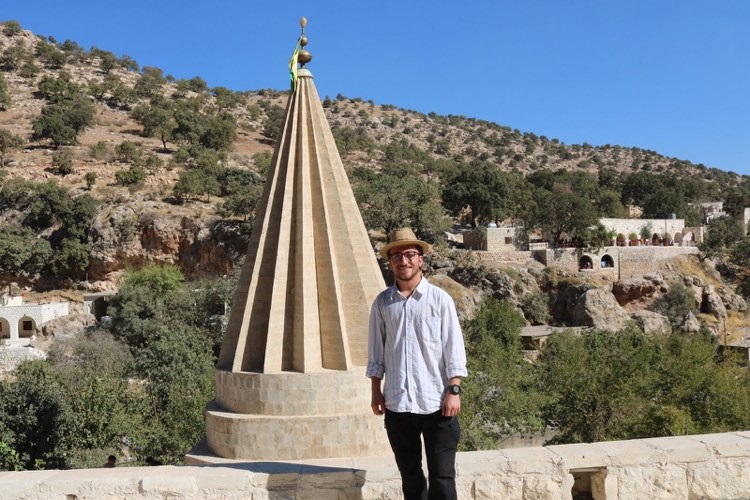
People walk towards the Temple of Lalish, near the Iraqi Kurdish city of Dohuk in Iraq. Photo: Ismail Adnan / AFP
ERBIL, Kurdistan Region - A joint investigation by a Yazidi rights organisation and international archeologists announced on Monday the publication of the final version of their report into the destruction of Yazidi cultural heritage by Islamic State (ISIS), calling on the deliberate annihilation of culture to be considered in future prosecutions of atrocity crimes, particularly genocide.
The collaborative project between Yazda, a multi-national NGO founded in 2014 to support victims of the Yazidi Genocide, the archaeologist network RASHID International, and the Endangered Archaeology in the Middle East and North Africa (EAMENA) Project, which itself is a collaborative response to the increasing threats to archaeological sites in the Middle East between the British Universities of Oxford, Durham and Leicester, may on the face of it seem irrelevant in comparison to the pain suffered by the Yazidi community in Iraq.
Over seven years after ISIS launched their ethno-religious genocidal campaign against the Yazidis in August 2014, resulting in the murder of 1,298 Yazidis alone on the first day ISIS attacked Sinjar, and the kidnapping of around 6,500 Yazidi women, over 2,700 of whom are still missing, around 400,000 members of the Yazidi community remain displaced today.
According to the Kurdistan Regional Government (KRG) Office for Rescuing Kidnapped Yazidis, over 120,000 Yazidis have left Iraq since ISIS waged their devastating campaign on the community, and tens of thousands of those who remain in the region live in Internally Displaced Camps (IDPS) such as Sharya, Khanke, Kabartu - and many more - in awful conditions.
Yet the value of cultural heritage, the report in the Asian Yearbook of Human Rights and Humanitarian Law sets out, goes deep into the psyche of communities, and the investigation - and presentation of it to the international community - is the first step towards ensuring that these deeds do not go unacknowledged and unpunished.
Sixty-eight Yazidi sites were destroyed by ISIS during their campaign against the Yazidis, according to the Department of Yazidi Affairs in the Ministry of Awqaf and the Department of Religious Affairs in the KRG, as the group targeted their spiritual and cultural sites they were so opposed to in an attempt to eradicate the religion completely.
In the publication edited by the United Nations Special Rapporteur on the human rights situation in Iran, Professor Javaid Rehman, “Cultural Heritage Destruction during the Islamic State's Genocide against the Yazidis”, the team closely considered 16 of the sites in the Bahzani area, and eight in the Sinjar area, providing “original research, evidence and context on the destruction of Yezidi’s tangible cultural heritage” through satellite imagery analysis, data and access to the sites. An earlier 2019 report is available to download online.
In the preface, His Holiness the Baba Sheikh - the highest religious authority in Yazidism - recalled how, after the liberation of Bashiqa and Bahzani, “people refused to return to their homes before the reconstruction of their shrines, thus demonstrating the strength of the Yazidi faith and showing the world their resilience.”
Saeed Yazidkhani, 23, places a similar value on his community's culture. Saaed fled ISIS in August 2014 and spent nine days without food and water in the nearby Sinjar mountains. In 2015, he moved to Qadia Camp near Dohuk, where he works as a translator for an NGO and teaches English to other survivors of ISIS.
He is a frequent visitor to Lalish, which although not destroyed by ISIS, played a significant role in sheltering Yazidis who fled from the group. Yazidkhani told Rudaw English from Dohuk on Monday that, “Lalish temple is the holiest and most sacred place for all Yazidis around the world.”

“It’s the first temple that most Yazidis come to visit every year, and they visit it at least once a year.”
“It’s an incredibly peaceful place to visit, and important to our community. ISIS tried to destroy our community’s history, and Lalish is an important place for visitors to come and learn about our beliefs, for example during festival periods”.
The main festival takes place from October 7 to October 14 every year, and attracts many international tourists to the historical site. Indeed, the Yazidi religion counts among some of the oldest in the world. “Lalish temple was built 2,000 years ago”, Saaed boasts.
Protected by the KRG, the site has been awarded “Outstanding Universal Value” status by the United Nations Educational, Scientific and Cultural Organisation (UNESCO), and the report encourages UNESCO to award Lalish Temple and its surroundings to the World Heritage List.
The report concludes that “the destruction of the cultural heritage of the Yazidi people constituted a war crime, a crime against humanity (persecution) and compelling evidence of genocidal intent”, recommending that the destruction of cultural heritage be considered in the prosecution of atrocity crimes, the International Criminal Court and national prosecutors open investigations wherever jurisdiction allows, and that the international community assist with the reconstruction of Sinjar and Bahzani to prevent Yazidi culture from being lost forever.








Comments
Rudaw moderates all comments submitted on our website. We welcome comments which are relevant to the article and encourage further discussion about the issues that matter to you. We also welcome constructive criticism about Rudaw.
To be approved for publication, however, your comments must meet our community guidelines.
We will not tolerate the following: profanity, threats, personal attacks, vulgarity, abuse (such as sexism, racism, homophobia or xenophobia), or commercial or personal promotion.
Comments that do not meet our guidelines will be rejected. Comments are not edited – they are either approved or rejected.
Post a comment